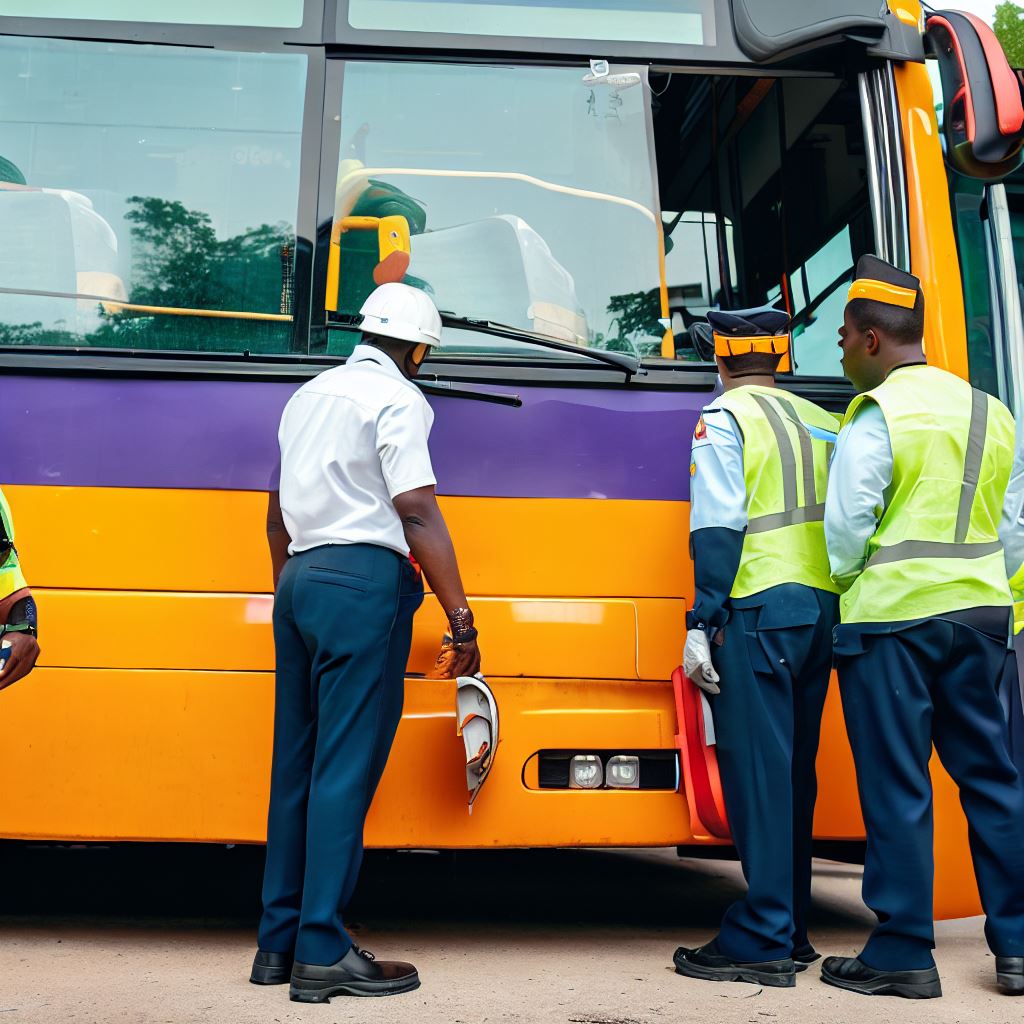Introduction
In the bustling landscape of Nigeria’s transportation system, the role of bus drivers and transit safety standards cannot be overstated.
It is not merely a matter of convenience; it’s a fundamental necessity for safeguarding public safety and enhancing overall transportation efficiency.
Safety standards serve as the unwavering guardians of passengers, drastically reducing the incidence of accidents that could otherwise jeopardize countless lives.
They encompass a wide array of aspects, from vehicle maintenance to driver training and compliance with traffic rules.
This blog post delves into the profound significance of safety standards for bus drivers and transit in Nigeria.
By upholding these standards, we not only mitigate risks but also elevate the efficiency of our transportation networks.
Passengers can travel with peace of mind, knowing that their well-being is a top priority, while the nation benefits from smoother and safer transit systems.
Bus drivers, too, play a pivotal role in ensuring adherence to these standards, making them the linchpin of this essential safety framework.
Current Safety Standards in Nigeria
Overview of existing safety regulations for bus drivers and transit
- Bus drivers must have a valid driver’s license and undergo regular medical examinations.
- Bus companies are required to provide training programs for drivers on safety procedures and defensive driving.
- Speed limits and traffic rules are mandated, and drivers found in violation can face penalties.
- Bus operators must maintain their vehicles and conduct regular inspections to ensure roadworthiness.
- Strict guidelines are in place for alcohol and drug testing of bus drivers to enforce sobriety while driving.
- Bus companies are required to keep records of driver schedules, rest periods, and working hours to avoid fatigue-related incidents.
Analysis of the effectiveness of current safety standards
- The existing safety standards have shown some level of effectiveness in reducing accidents on Nigerian roads.
- Enforcement of traffic rules and penalties has led to increased compliance among bus drivers.
- Regular vehicle maintenance and inspections have helped identify and address potential mechanical issues.
- Training programs have improved drivers’ awareness and skills, contributing to safer transit operations.
- Alcohol and drug testing have deterred drivers from driving under the influence, enhancing road safety.
Examples of the impact of inadequate safety standards on bus accidents
- Bus accidents resulting from over-speeding and reckless driving due to poor enforcement of speed limits.
- Accidents caused by mechanical failures and faulty brakes due to inadequate vehicle maintenance.
- Fatigue-related accidents caused by long working hours and the absence of proper rest periods for drivers.
- Accidents involving intoxicated drivers who were not subjected to alcohol and drug testing.
- Inadequate driver training leading to poor judgment and inability to respond effectively to road conditions.
Factors Contributing to Safety Issues
In order to address the safety concerns related to bus drivers and transit in Nigeria, it is crucial to identify the factors that contribute to these issues.
Several key factors have been identified as significant contributors to safety issues in the country.
Insufficient training and qualification requirements for bus drivers
One of the major factors contributing to safety issues in Nigeria’s bus transit system is the lack of sufficient training and qualification requirements for bus drivers.
Currently, the standards for becoming a bus driver are not strict enough, leading to unqualified individuals operating buses.
Without proper training, drivers may lack the necessary skills and knowledge to handle different situations on the road, such as driving in adverse weather conditions or handling emergencies.
This puts the safety of passengers and other road users at risk.
Lack of regular driver evaluation and monitoring
Another factor that contributes to safety issues is the lack of regular driver evaluation and monitoring.
There is a need for a robust system that regularly assesses bus drivers’ performance, ensuring that they consistently meet safety standards.
Without regular evaluations, drivers may become complacent or develop bad habits over time.
Monitoring can help identify areas where additional training or support is needed, improving overall driver competence and reducing the likelihood of accidents.
Inadequate vehicle maintenance and inspection protocols
The lack of proper vehicle maintenance and inspection protocols is another factor that contributes to safety issues in Nigeria’s bus transit system.
Many buses in the country are not adequately maintained, leading to mechanical failures and accidents.
Regular inspections and maintenance can help identify potential issues before they become safety hazards.
Implementing stricter protocols for vehicle maintenance can ensure that buses are in optimal condition and minimize the risk of accidents caused by mechanical failures.
Poor infrastructure and road conditions
Poor infrastructure and road conditions also contribute to safety issues in Nigeria. Many roads are poorly constructed or lack proper signage, posing dangers to bus drivers and passengers.
Improving road infrastructure and addressing issues such as potholes and inadequate lighting can significantly enhance road safety.
This includes constructing well-designed bus stops, implementing traffic control measures, and ensuring proper road maintenance to minimize accidents and improve overall transit safety.
Influence of external factors like traffic congestion and weather conditions
External factors, such as traffic congestion and adverse weather conditions, further contribute to safety issues in Nigeria’s bus transit system.
Traffic congestion can lead to increased stress levels for drivers and result in aggressive driving behaviors, increasing the likelihood of accidents.
Adverse weather conditions, such as heavy rainfall or fog, can reduce visibility and make driving more challenging, increasing the risk of collisions.
Efforts should be made to address these external factors by implementing traffic management strategies, improving road infrastructure, and providing weather alerts to drivers.
Additionally, educating drivers on defensive driving techniques can help them navigate challenging conditions safely.
In fact, several factors contribute to safety issues in Nigeria’s bus transit system.
These include insufficient training and qualification requirements for drivers, lack of regular evaluation and monitoring, inadequate vehicle maintenance protocols, poor infrastructure and road conditions, as well as external factors like traffic congestion and weather conditions.
Addressing these factors through stricter regulations, improved infrastructure, and comprehensive training programs is essential to ensure the safety of bus drivers and passengers in Nigeria.
Read: Top Routes for Intercity Bus Travel in Nigeria Explained
Impact of Safety Standards on Passengers and Society
Increased public trust and confidence in public transportation
Safety standards for bus drivers and transit in Nigeria play a crucial role in increasing public trust and confidence in public transportation.
When passengers know that there are strict safety protocols in place, they feel more secure and are more likely to use public transportation.
Reduction in the number of accidents, injuries, and fatalities
Implementing safety standards for bus drivers and transit in Nigeria can result in a significant reduction in the number of accidents, injuries, and fatalities.
These standards ensure that drivers are properly trained, vehicles are regularly maintained, and safety protocols are followed, minimizing the risks associated with public transportation.
Economic benefits of a safer transportation system
A safer transportation system leads to several economic benefits for both passengers and society as a whole.
When accidents and injuries are reduced, medical costs decrease, insurance premiums go down, and public resources can be allocated to other areas of need.
Additionally, a safer transportation system attracts more passengers, resulting in increased revenue for transport companies.
Improved public perception of the government’s commitment to safety
By implementing and enforcing safety standards for bus drivers and transit in Nigeria, the government showcases its commitment to the safety and well-being of its citizens.
This improves the public perception of the government’s ability to govern effectively and take necessary measures to protect its people.
In short, safety standards for bus drivers and transit in Nigeria have a significant impact on both passengers and society.
They increase public trust and confidence in public transportation, reduce the number of accidents, injuries, and fatalities, bring economic benefits, and improve the public perception of the government’s commitment to safety.
It is crucial for authorities to continue prioritizing and enforcing these safety standards to ensure a safe and reliable transportation system for all.

International Safety Standards and Best Practices
Comparative analysis of safety standards in other countries
- Conducting a comprehensive review of safety standards adopted by various countries.
- Identifying similarities and differences between Nigeria’s current safety standards and those elsewhere.
- Assessing the potential benefits and drawbacks of adopting different safety standards.
- Highlighting countries with exemplary safety records to serve as benchmarks for Nigeria.
Examination of successful safety practices implemented elsewhere
- Investigating case studies of countries that have successfully improved bus driver safety.
- Analyzing the strategies and methods used to enhance safety practices.
- Identifying key factors contributing to the success of these safety practices.
- Extracting lessons and best practices that can be applied in Nigeria’s context.
Adaptability of international standards and practices to the Nigerian context
- Evaluating the feasibility of implementing international safety standards in Nigeria.
- Considering the cultural, economic, and infrastructural factors influencing the adoption of these standards.
- Identifying potential challenges and barriers to implementing international practices.
- Proposing recommendations and modifications to ensure effective implementation in Nigeria.
Read: Challenges and Rewards of Being a Bus Driver in Nigeria
Gain More Insights: Nigeria’s Top Fundraising Professionals: A Closer Look
Proposals for Enhancing Safety Standards
Strengthening driver training and certification programs
- Implement comprehensive driver training programs that cover both theoretical knowledge and practical skills.
- Ensure that training programs include topics such as defensive driving, emergency procedures, and passenger safety.
- Require bus drivers to pass rigorous tests and obtain certifications before they are allowed to operate.
- Collaborate with reputable training institutions to develop standardized training curricula.
Implementing regular driver evaluation and performance monitoring procedures
- Establish a system for regular driver evaluations that assess their knowledge, skills, and adherence to safety regulations.
- Conduct periodic performance monitoring to identify areas for improvement and provide necessary support and training.
- Use advanced technology, such as onboard cameras and GPS tracking systems, to monitor driver behavior and performance.
- Establish clear performance benchmarks and enforce consequences for drivers who consistently fail to meet standards.
Encouraging vehicle maintenance and inspection by imposing penalties for negligence
- Introduce stricter regulations to ensure regular vehicle maintenance and inspection, including routine checks for safety equipment.
- Impose significant penalties, including fines and suspension of licenses, for transportation companies that neglect maintenance.
- Strengthen enforcement mechanisms to ensure compliance with maintenance and inspection requirements.
- Promote awareness among drivers and transportation companies about the importance of regular vehicle upkeep.
Enhancing transportation infrastructure and improving road conditions
- Invest in the development and improvement of transportation infrastructure, including roads, bridges, and bus terminals.
- Conduct regular maintenance and repairs to ensure safe and smooth traveling conditions for bus drivers and passengers.
- Collaborate with relevant government agencies and stakeholders to identify and address areas of high accident risk.
- Implement road safety measures, such as speed limits, traffic signs, and pedestrian crossings, to reduce accidents.
Collaboration between government agencies, transportation companies, and relevant stakeholders
- Foster collaboration and communication between government agencies, transportation companies, and driver associations.
- Establish a joint task force that regularly meets to address safety concerns and develop strategies for improvement.
- Share information and best practices to ensure consistent safety standards across the public transportation sector.
- Encourage stakeholder participation in the development and implementation of safety policies and regulations.
By implementing these proposals, Nigeria can significantly enhance the safety standards for bus drivers and transit, reducing the number of accidents and ensuring a safer public transportation system for all.
Read: Nigeria’s Transit System: A Guide to Bus Fare Structures
Challenges and Solutions for Implementation
Lack of awareness, resistance, and compliance issues
- The first challenge revolves around the lack of awareness among bus drivers and transit organizations.
- Drivers may be resistant to change due to unfamiliarity and perceived additional burdens.
- Compliance issues arise when drivers and transit organizations do not adhere to safety standards.
- Solutions to address these challenges include comprehensive education and training programs.
- Creating awareness campaigns can help drivers understand the importance of safety standards.
- Engaging stakeholders in open communication channels can help alleviate resistance.
- Strict enforcement and monitoring mechanisms are required to ensure compliance.
Financial constraints and resource limitations
- Procuring safety equipment such as seatbelts and surveillance systems can be costly.
- Allocating funds for comprehensive training programs may strain limited resources.
- Collaboration with government bodies and international organizations can help access financial support.
- Seeking partnerships with private companies can assist in acquiring necessary resources.
- Exploring innovative solutions and cost-effective alternatives can mitigate financial constraints.
- Advocating for increased government funding and subsidies can ease financial burdens.
Strategies for overcoming challenges to effectively implement safety standards
- Educational campaigns and workshops should be conducted regularly to raise awareness.
- Creating incentives and rewards for compliance can motivate bus drivers and transit organizations.
- Engaging in dialogue with stakeholders will help address concerns and build collaboration.
- Enhancing regulatory frameworks and penalties will ensure strict enforcement of safety standards.
- Continuous monitoring and evaluation systems should be put in place to track compliance.
- Collaborating with international partners can provide expertise and technical assistance.
- Integrating technology-driven solutions, such as driver monitoring systems, can enhance safety standards.
- Establishing a dedicated entity or department responsible for overseeing safety standards implementation can ensure accountability.
Read: Bus Driver Training in Nigeria: Schools, Costs, & More
Conclusion
Recap of the importance of safety standards for bus drivers and transit in Nigeria
Ensuring safety standards for bus drivers and transit in Nigeria is of paramount importance.
It is crucial for the protection of passengers’ lives and the overall development of the transportation sector.
Summary of proposed actions to enhance safety standards
To enhance safety standards, several actions need to be taken. First, there should be strict regulations and guidelines for bus drivers, including regular training and assessment of their skills.
Additionally, bus operators should prioritize vehicle maintenance and ensure the availability of safety equipment onboard.
Call to action for stakeholders to prioritize and actively work towards improving safety standards in the transportation sector
We urge all stakeholders, including the government, transportation authorities, bus operators, and drivers’ associations, to prioritize safety standards.
Collaborative efforts are required to implement and enforce safety measures, including regular inspections, strong penalties for violations, and awareness campaigns for drivers and passengers.
By taking these actions, we can create a safer and more reliable transportation system in Nigeria.
Let us all work together to prevent accidents, save lives, and build a better future for the country.




